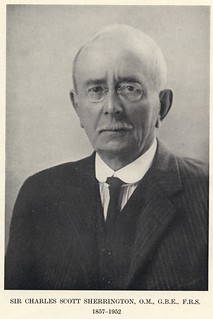- Creation
-
Creators (Definite): Sir Charles Scott Sherrington; The Cambridge Scientific Instrument CompanyDate: 1885
- Current Holder(s)
-
- No links match your filters. Clear Filters
-
Cited by
 C.S. Sherrington, 'On Secondary and Tertiary Degenerations in the Spinal Cord of the Dog', Journal of Physiology 6 (4-5) (1885), pp. 177-191.
C.S. Sherrington, 'On Secondary and Tertiary Degenerations in the Spinal Cord of the Dog', Journal of Physiology 6 (4-5) (1885), pp. 177-191.
Description:Explanation of Plate V, figs. 13-15:
'Fig. 13. Diagram to show the constitution of tbe dorsal portion of the lateral columns of the cord in the cervical region of the dog.
The dotted line marks out the area of the pyramidal tract as laid down by the date of acquirement of medullary sheath by the nerve-fibres.
The smaller circles indicate the distribution of the fibres of the crossed pyramidal tract as laid down by degeneration secondary to cortical lesions.
The larger circles with a central dot indicate the fibres of the re-crossed pyramidal tracts.
The crosses indicate fibres between those of the crossed and re-crossed pyramidal tracts, which do not degenerate secondarily after cortical lesions, but some of which do undergo the tertiary degeneration.
Fig. 14. The same, after destruction of the "cord-area" of the left cerebral hemisphere.
Fig. 15. The same, after destruction of the "cord -areas" of both hemisppheres.' (191)
Figs. 13-15 in text:
'These observations point to the dorsal angle of the lateral columns being occupied by nerve-fibres of several tracts commingled. In the cervical region for instance it contains
(a) fibres belonging to the crossed pyramidal tract, from the cordarea of the cortex of the opposite hemisphere.
(b) fibres belonging to the re-crossed pyramidal tracts, belonging to the cord-area of their own-side hemisphere.
(c) fibres which a tertiary degeneration involves.
(d) fibres which are unaffected by the secondary or tertiary degenerations -
i. small and numerous.
ii. large and less numerous.
(e) fibres which acquire the medullary sheath at the samne time that the fibres from the cord-area of the hemisphere do, but which do not degenerate with them.
(f) scattered fibres which do not acquire the medullary sheath at the same time as do the fibres (a) and (e).
Perhaps (e), or (f), or both, should be classed with (c) or (d) or even with (b). Figs. 13, 14 and 15, P1. V, diagrammatically represent the composition of this part of the lateral columns. The explanation of the diagrams is on p. 191.' (188)








